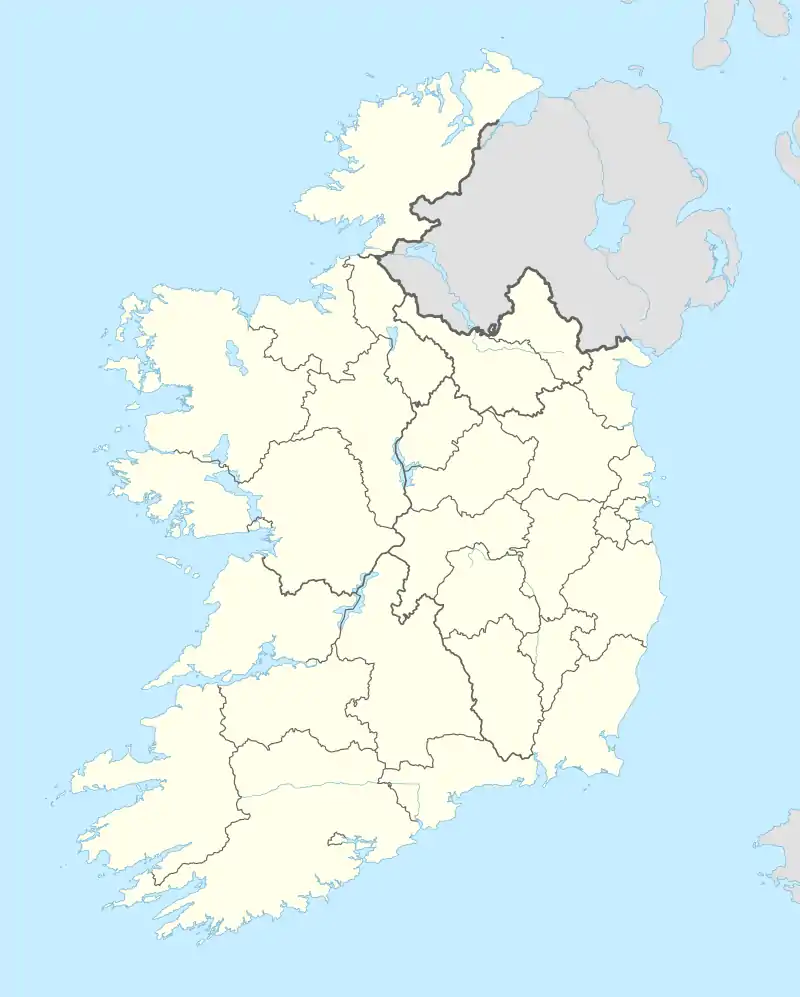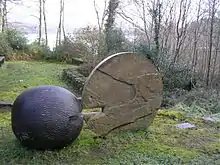Glenfarne
Glenfarne (Irish: Gleann Fearna) is a small village in north County Leitrim, Ireland. It is the site of the original "Ballroom of Romance", which inspired a short story by William Trevor and was subsequently turned into a movie by the BBC. Glenfarne has a lakeside forest near Lough MacNean. The village is located on the N16 (Sligo–Blacklion) road, east of Manorhamilton.
Glenfarne
Gleann Fearna | |
|---|---|
Village | |
 N16 through village | |
 Glenfarne Location in Ireland | |
| Coordinates: 54.28429°N 7.984°W | |
| Country | Republic of Ireland |
| Province | Connacht |
| County | County Leitrim |
History
The name of the village is an anglicisation of Gleann-fearna, meaning "valley of the alders".[1] It was referred to by this name in the Annals of the Four Masters as far back as 1235[2] as a location in West Bréifne and under a further derivation, Clann-Fearmaighe as far back as 1217, where it is cited as "containing 20 quarters of land".[3]
Historical remains
- Ruins of Glenfarne Hall – in Glenfarne Forest Park, which formed part of the Tottenham estate, the ruins of the old house, Glenfarne Hall, can still be seen. The estate passed from the Tottenhams to Sir Edward Harland (of Harland and Wolff shipbuilders, Queen's Island, Belfast). Sir Edward Harland died at Glenfarne Hall on Christmas Eve, 24 December 1895. It's said that the flag stones that line the Titanic quay come from quarries in Glenfarne.
- Myles Big Stone – this is thought to have been an ancient place of worship. Nearby is the Fort of Sile O'Reilly which is reputed to have been an ancient burial ground and a famine graveyard for infants.

Glenfarne Demesne
The Glenfarne Demesne lies on the shores of Lough MacNean. The lake marks the border between the counties of Leitrim, Cavan and Fermanagh. In 2000, a cross-border and cross-community arts project was concluded with the aim to promote the bonds between the communities of these three counties through the medium of sculpture and the visual arts. A number of sculptures are still in the Demesne.[4]
Transport
Rail
Glenfarne railway station was on the Sligo, Leitrim and Northern Counties Railway line from Enniskillen to Sligo. The line opened in 1880 and closed in 1957.[5] The nearest operational station is Sligo railway station.
Bus
Glenfarne is a stop on Bus Éireann regional routes 458 (Ballina–Enniskillen) and 470.[6]
References
- Joyce, P. W. (1887). The Origin and History of Irish Names of Places. I (5th ed.). Dublin: M. H. Gill and Son. p. 515.
- O'Donovan, John, ed. (1856). "From the earliest period to the year 1616". Annals of the Kingdom of Ireland. VII (2nd ed.). Dublin: Hodges, Smith and Co. p. 64.
- O'Donovan, John, ed. (1856). "From the earliest period to the year 1616". Annals of the Kingdom of Ireland. VII (2nd ed.). Dublin: Hodges, Smith and Co. p. 29.
- http://www.coillte.ie/aboutcoillte/community/community_partnerships/connaught/glenfarne_demesne_co_leitrim/
- "Glenfarne station" (PDF). Railscot – Irish Railways. Retrieved 2007-10-14.
- "Regional Services by County". Bus Éireann. Retrieved 2020-09-03.
